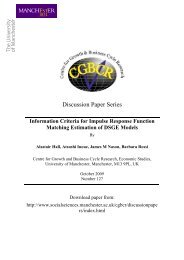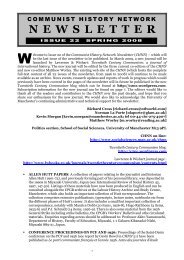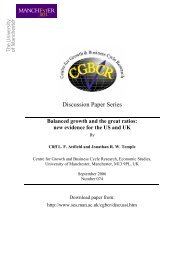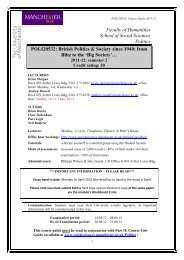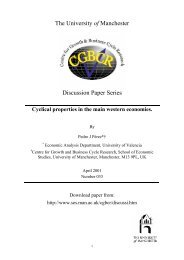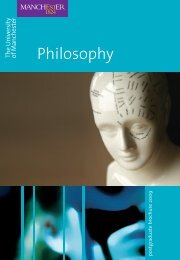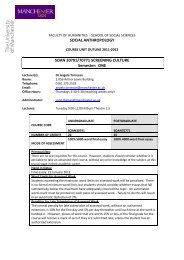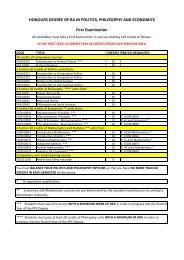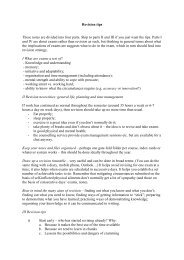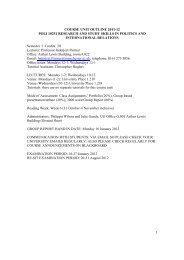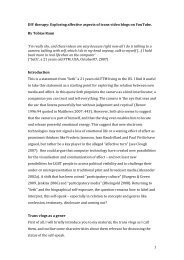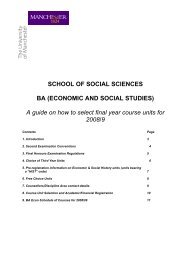second year course outlines 2012-2013 - School of Social Sciences ...
second year course outlines 2012-2013 - School of Social Sciences ...
second year course outlines 2012-2013 - School of Social Sciences ...
You also want an ePaper? Increase the reach of your titles
YUMPU automatically turns print PDFs into web optimized ePapers that Google loves.
Heidegger right to claim that the perception <strong>of</strong> a chair as hard is really, primarily, the<br />
perception<br />
<strong>of</strong> it as uncomfortable.<br />
3. Heidegger argues, in §5c(β) that indirect (picture based) accounts <strong>of</strong> perception are<br />
falsified by<br />
the phenomenology, according to which the perceived is ‘bodily there’. Is he right? He also<br />
argues that they fall down to an infinite regress objection. Is this a convincing argument?<br />
4. Heidegger only mentions sensation in his rejection <strong>of</strong> ‘indirect’ accounts <strong>of</strong> perception. Do<br />
you<br />
think that this is right? Is there such a thing as perceptual sensation or can perception be<br />
characterised entirely in terms <strong>of</strong> intentionality and ‘bodily presence’?<br />
18<br />
Lecture 6 (Week 7): Perception II – perceiving and doing (Heidegger)<br />
Required Reading:<br />
Heidegger, M. The Worldhood <strong>of</strong> the World. In Moran, D. & Mooney, T. The<br />
Phenomenology<br />
Reader. London: Routledge, 2002. [S]<br />
Recommended Reading:<br />
Hall, H. 1993. Intentionality and World: Division I <strong>of</strong> Being and Time. In C. Guignon, ed.<br />
Cambridge Companion to Heidegger, 1st Edition. Cambridge: Cambridge University Press.<br />
[O]<br />
Further Reading:<br />
Blattner, W. 1999. Is Heidegger a Representationalist? Philosophical Topics 27<br />
Carman, T. 2003. Heidegger’s Analytic: Interpretation, Dis<strong>course</strong> and Authenticity in Being<br />
and<br />
Time. Cambridge: Cambridge University Press, Chs.2-3<br />
Cerbone, D. 1999. Constitution and Composition: Heidegger’s Hammer. Philosophical<br />
Topics<br />
27 (1999) [D]<br />
Christensen, C. B. 1997. Heidegger’s Representationalism. Review <strong>of</strong> Metaphysis 51 [O]<br />
*Dreyfus, H. 1991. Being-in-the-World: A Commentary on Heidegger’s Being and Time,<br />
Division 1. Cambridge, MA: MIT Press, Ch.3-5 [S] [D = Ch.3]<br />
*Moran, D. 2000. Heidegger’s Critique <strong>of</strong> Husserl’s and Brentano’s Accounts <strong>of</strong><br />
Intentionality.<br />
Inquiry 43 [O]<br />
Richardson, J. 1991. Existential Epistemology: A Heideggerian Critique <strong>of</strong> the Cartesian<br />
Project. Oxford: Oxford University Press, Part I, ‘Everydayness’ [O]<br />
*S<strong>of</strong>fer, G. 1999. Phenomenologizing with a Hammer: Theory <strong>of</strong> Practice? Continental<br />
Philosophy Review 32 (1999) [O]<br />
19<br />
The Topic<br />
We don’t just think about things and see things, we do things. And, usually, we do things<br />
with<br />
things—we drive in the nail with the hammer, type with the computer, scrub with the brush.<br />
When<br />
we engaged in such activities, how do the objects with which we are engaged appear to us?<br />
Heidegger’s influential answer to this question incorporates his important distinction between<br />
the<br />
ready-to-hand and the present-at-hand, and his claim that the world is, essentially, a<br />
normative,<br />
meaningful structure. It is <strong>of</strong>ten presented as an account <strong>of</strong> our most fundamental relation to<br />
the<br />
world—one which makes Husserlian intentionality possible.<br />
53



